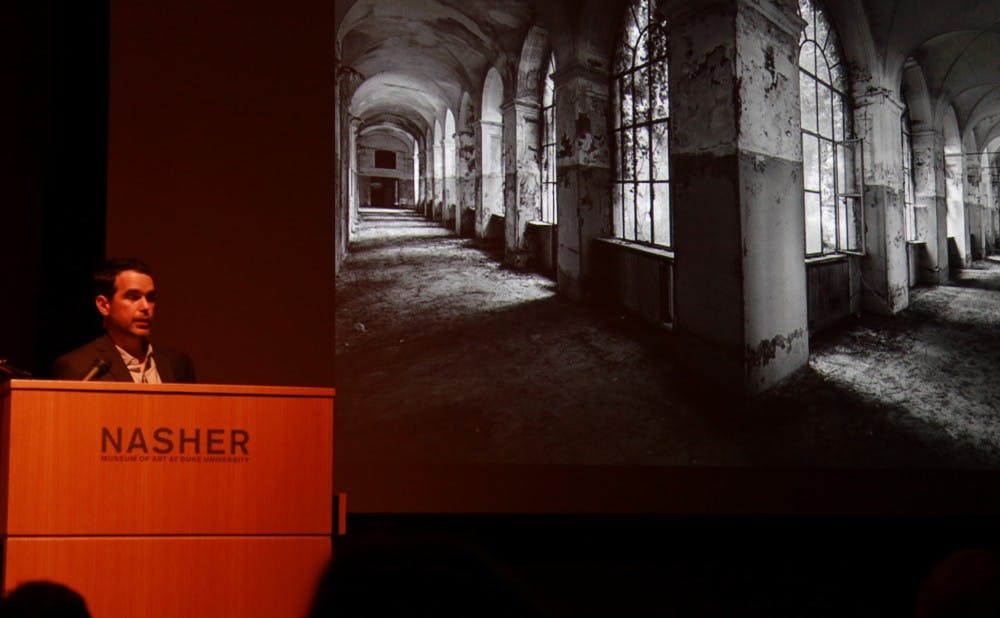Artist Dario Robleto visited the Nasher Museum of Art Feb. 1 to present his lecture, “A Dream, As Faithful As a Flame.” In it, he included a collection of historical recordings of human brain activities, heartbeats and voices. His slides introduced the audience to sound recordings that previous researchers had left behind, such as Thomas Edison’s voice recording of himself singing “Mary Had a Little Lamb.”
Through the recordings, Robleto brought up questions about whether it would be possible to visualize the seemingly “immaterializable” human mind and make it readable and interpretable to both humans and species outside of the Solar System.
To organize the lecture, the Nasher Museum of Art received support from its Reflections Program for visitors with dementia and their caregivers and a Bass Connections team, which collaborates with the museum and the Duke Division of Geriatrics. The team suggested inviting Robleto and Jose Contreras-Vidal, a University of Houston engineering professor who gave a talk on the day before the lecture, to promote conversations about using museums as public laboratories.
Jessica Ruhle, director of education and public programs at the Nasher, said Robleto’s works covering disciplines in both arts and sciences fit the interests of Duke’s population.
“We have neuroscience majors who love the museum and who are musicians. We have art majors who are fascinated by breakthroughs in science,” Ruhle said. “Also, we are fortunate that we have phenomenal experts of both fields and initiatives that are happening on campus.”
Robleto refers to himself as a “transdisciplinary artist.” He wrote in an email that “transdisciplinary” approaches are similar to interdisciplinary ones but reflect more fully an intertwined investment across disciplines.
“For me, transdisciplinarity is not about referencing another discipline, or a temporary engagement for one project,” he wrote. “It is a full merger so that the boundary lines between disciplines become blurred to the point of irrelevance.”
The artist became particularly interested in the recordings of human brain activities, voices and heartbeats as a child. He had a deep fascination with the Voyagers, robotic probes that NASA sent to explore the outer Solar System in the late 1970s. What impressed him the most was the Golden Record, an LP record loaded onto the probes that carried images, music, languages and the scans of electrical activities of the heart and the brain of a 27-year-old woman, Ann Druyan, who had just fallen in love. He wrote that the event inspired him to devote himself to answering the question, “What does one gift to the only woman whose heart and mind have left the Solar System?”
Robleto pursued that question, revealing fascinating aspects about the way people related to time, memory and death. He proceeded with his works as an artist and researcher through his transdisciplinary approach, which allowed him to understand a seemingly incomprehensible concept by looking at it through multiple lenses.
He uses diverse media ranging from buttons to old boots to present his work to the audience.
“Making the argument that a millions of years old dinosaur bone can illuminate the political struggles of the ’60s through rock ‘n’ roll … is asking viewers to expand the scope of how they understand at any given moment,” he wrote. “I feel [that using diverse media] is a way to offer a type of re-enchantment with the world that there are access points to each other across vast times and places all around us … if we just get creative about where to look.”
The lecture ended with a conversation session with Robleto. The audience was still left with questions about whether the heartbeats and the brain activities recorded in the Golden Record would ever be played and interpreted by someone outside of the Solar System. But Robleto wrote that he believed in the value of those recordings.
“We have this desire to know if others have felt what we feel, to let each other know we are not alone,” he wrote. “I feel we need to think that way not only for our own planet, but cosmically as well. If some future intelligence is also curious about these questions, then we need to have left some access to do so.”
Get The Chronicle straight to your inbox
Signup for our weekly newsletter. Cancel at any time.

